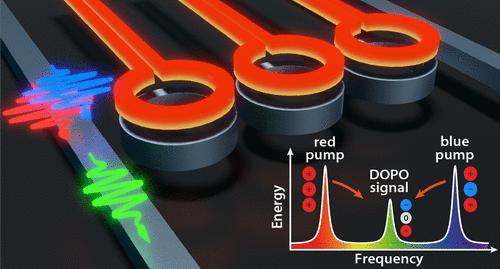利用耦合微谐振器实现可调谐偏振光参量振荡
IF 6.5
1区 物理与天体物理
Q1 MATERIALS SCIENCE, MULTIDISCIPLINARY
引用次数: 0
摘要
基于微谐振器的变性光参量振荡(DOPO)最近被视为全光计算和量子信息应用(如真正的随机数生成和光挤压态的产生)的一个引人注目的平台。新近的研究突显了耦合微谐振器或光子分子作为光谱工程新途径的潜力,为优化四波混合相互作用提供了额外的自由度。在这里,我们展示了氮化硅三重态光子分子耦合模式中的单个可调 DOPO。我们的设计引入了一种独特的光谱工程机制,利用微加热器来单独调节共振谱位置,从而实现耦合模式内的动态局部色散控制。我们成功生成了具有主动效率控制功能的 DOPO 信号,并探索了数十兆赫范围内的光学模式间距,以便使用由射频源驱动的本机锁相光泵。本文章由计算机程序翻译,如有差异,请以英文原文为准。

Tunable Degenerate Optical Parametric Oscillation with Coupled Microresonators
Microresonator-based degenerate optical parametric oscillation (DOPO) has recently been explored as a compelling platform for all-optical computing and quantum information applications such as truly random number generation and the production of squeezed states of light. Emerging research has highlighted the potential of coupled microresonators, or photonic molecules, as a novel avenue for spectral engineering, unlocking an extra degree of freedom for the optimization of four-wave mixing interactions. Here, we demonstrate a single tunable DOPO within the coupled modes of a silicon nitride triplet-state photonic molecule. Our design introduces a distinctive mechanism for spectral engineering, using microheaters to individually tune the resonance spectral positions, thus enabling dynamic local dispersion control within the coupled modes. We successfully generated a DOPO signal with active efficiency control and explored the optical mode spacing in the tens of gigahertz range to use native phase-locked optical pumps driven by a radio frequency source.
求助全文
通过发布文献求助,成功后即可免费获取论文全文。
去求助
来源期刊

ACS Photonics
NANOSCIENCE & NANOTECHNOLOGY-MATERIALS SCIENCE, MULTIDISCIPLINARY
CiteScore
11.90
自引率
5.70%
发文量
438
审稿时长
2.3 months
期刊介绍:
Published as soon as accepted and summarized in monthly issues, ACS Photonics will publish Research Articles, Letters, Perspectives, and Reviews, to encompass the full scope of published research in this field.
 求助内容:
求助内容: 应助结果提醒方式:
应助结果提醒方式:


